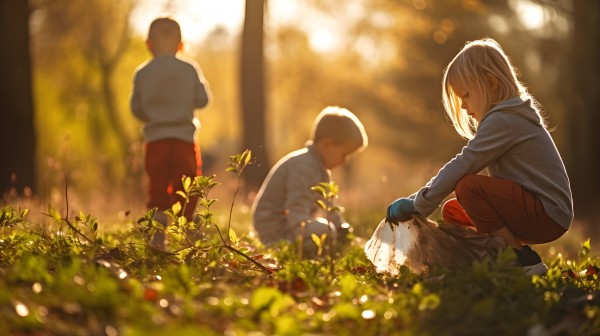Raising children to be active, helpful community members is a valuable goal and can be achieved through intentional actions and mindset shifts.
Having exposure to opportunities for children to help in their community can strongly impact a child’s social skills and emotional development. In raising children to be helpers, parents are supporting the benefit of their child being part of a functioning society. A current 2024 research study finding by Early Childhood Research Quarterly showed that parents reported a higher sense of self and self-efficacy skills in their young children’s development when they provided opportunities for their child to learn how to help others. They also described that when their young children took more job-like roles in the community and took the initiative to help others, there was less stress in the family environment due to these habits of helpfulness being learned at home. Research by The American Academy of Pediatrics suggests that teaching a child jobs and responsibilities, such as being a helper doing chores, can help to establish a sense of accomplishment and cooperation skills in their development. Having dinnertime discussions with your young children about how to be a helper, the importance of being a helper in their community, and the purpose of social responsibilities is extremely important. Modeling these helpful behaviors in your community is also relevant to remember as children learn from what they see, do, and experience in their environment.

Age-Appropriate Helpful Actions
Here is a list of age-appropriate ideas for easy, small tasks young children can do to help others.
Toddlers (12-48 months of age): They are capable of easy tasks. For instance, handing objects to people and pointing to give directions. They have beginning physical skill capabilities to manipulate objects and can help with doing simple jobs in the community. Such as picking up trash, putting things away, or handing out items.
Preschoolers (48-60 months of age): They can perform more challenging and harder tasks, such as serving, fixing, and putting things together. They have greater physical skill capabilities to manipulate objects. They can help do more complex jobs in the community, such as serving items to others, solving a simple problem, or creating and distributing objects or materials.
At Children’s Lighthouse, we understand the value of teaching children how to be helpers. Did you know that our curriculum's October Character Value of the Month is helpfulness? We believe in teaching young children this life skill in our classroom programs. Each of our preschool classrooms has a Lighthouse CARES® Job Chart to help nurture essential life skills, foster classroom cohesion, and give children a sense of ownership within a community. Additionally, incorporating helpful actions like this into your family values, home rituals, or community benefits life-long learning for children. Strategies To Build Helpfulness Skills
Here are some strategies to foster a sense of community responsibility and helpful community service in children:
1. Model Community Involvement: Children often imitate the behavior of adults. Be an active participant in your community—volunteer, attend local events, or help neighbors—and involve your children in these activities. Your example can be a powerful motivator for them to do the same.
2. Teach Empathy and Compassion: Discuss the importance of understanding and caring for others. Share stories or experiences that highlight the impact of kindness and generosity. Encourage your children to think about how their actions affect others and to consider different perspectives.
3. Encourage Volunteering: Find age-appropriate volunteer opportunities for your children. This could include helping at a local food bank, participating in community clean-up days, or volunteering at animal shelters. Tailor the activities to their interests and abilities to keep them engaged.
4. Foster Responsibility and Independence: Give children responsibilities at home and in their community. This might include chores, caring for pets, or organizing community events. Allow them to take ownership of projects, which helps build their confidence and sense of accomplishment.
5. Promote Teamwork and Collaboration: Encourage your children to work with others on community projects or in school. Group activities teach valuable skills like cooperation, communication, and problem-solving, all of which are essential for effective community involvement.
6. Support Their Interests: If your child has a passion or interest, find ways to connect that with community service. For instance, if they love art, they could participate in or organize community art projects. If they're interested in technology, they might help with tech education for seniors.
7. Celebrate Contributions: Recognize and celebrate your child’s efforts and achievements in helping others. Positive reinforcement helps them understand the value of their contributions and encourages them to continue their community involvement.
8. Provide Opportunities for Leadership: Allow your child to take on leadership roles in community activities or projects. Leadership experiences help them develop skills and confidence, and they learn how to motivate and inspire others to get involved.
9. Discuss Social Issues: Engage in age-appropriate discussions about social issues and community needs. Understanding the broader context helps children appreciate the importance of their contributions and motivates them to be part of the solution.
10. Encourage Critical Thinking: Teach children to think critically about community needs and how they can address them. Encourage them to come up with their own ideas for helping others and support them in implementing these ideas.
By integrating these practices into your daily life and discussions, you can help instill a strong sense of community responsibility and a lifelong commitment to learning the importance of helping others for your child.
Children Helping In Their Community
In your community, you can engage and encourage your child to be a helper. Here are a few places and ideas to support teaching your child how to demonstrate helpfulness behaviors:
• At the grocery store – hold a door open for someone else.
• At a park – clean up trash.
• At a library – use a quiet voice to not disturb others, or help clean up books that have been left out and put them where they belong.
• At a neighbor’s house – help by offering to do a nice deed for them, such as watering their plants, taking in their groceries, or feeding their pets.
• At a local sporting event – they can hand out bottled water to guests or players.
• At a local church or donation center (such as a food bank or The Salvation Army®) – they can drop off items and goods, or give monetary donations to help a good cause
• In the Neighborhood – clean up trash, plant a new tree, or have your child host a lemonade sale to help raise donation funds for a local charity.
Teaching helpfulness skills does impact others all around us. Being a helper at home, school, and in the community are all essential concepts that young children can learn and should practice often.
_____________________________________________________________________________________________
References/Resources:
Early Childhood Research Quarterly (2024) https://doi.org/10.1016/j.ecresq.2024.08.002
American Academy of Pediatrics (2024) Age-Appropriate Chores for Children - HealthyChildren.org



